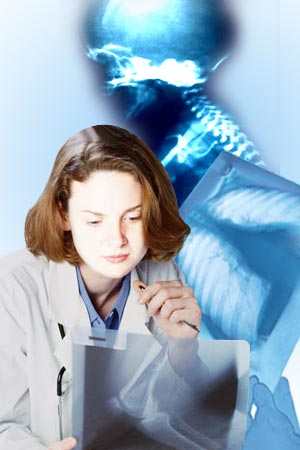Bone Density Test

Osteoporosis thins your bones and makes them susceptible to breakage. A bone density test is a screening technique. Bone mineral density (BMD) test is a noninvasive test that determines your bone strength. Early onset of osteoporosis can be detected by decreased density of normal bone. Typically mineral density in the bones of women increases till about 35 years.
With the onset of menopause, bone mineral density sees a sharp decline. Building a high overall bone density helps in warding off osteoporosis in later years. Bones tend to become porous when calcium is depleted faster from the bones than it is added. The loss of bone density cannot be detected by regular x-rays.
Bone density test
The popular methods of bone density testing are single energy x-ray densiometry (SXA) and dual energy x-ray densimetry (DEXA). SXA and DEXA bone density tests are relatively cheaper than other investigative tests such as QCT - Quantitative computed tomography and radiographic absorptiometry. The DEXA bone mineral density test in painless and does not involve injections, special diets or sedation. During this bone density test, the person's bone density is tested with radiation. The scan is done on one or more areas of bone, be it the hip or lower spine.
The bone density data is interpreted in comparison with what is considered normal for a healthy young person. DEXA bone density tests use 2 different x-ray beams for calculating bone density. One energy beam is absorbed by soft tissue and the other by bone. When the soft tissue amount is deducted from the total, it gives you a picture of the person's bone mineral density. Bones with higher mineral density allow less of the X-ray beam to pass through them. DEXA uses lesser radiation than ultrasound testing.
Machines used to measure bone density vary - from central machines that measure density in the hip and spine to peripheral machines that measure bone density in fingers, kneecaps, heels and wrists. Peripheral DEXA machines are easily portable and are useful in tracking the effect of medication on osteoporosis. You can build up bone density with calcium and Vitamin D supplements. Walking and weight bearing exercises go a long way in building bone density.
Bone mineral density test
Bone mineral density tests help in assessing your bone health as well as the rate of bone loss in case you are already suffering from osteoporosis. Bone density accounts for about 80 % of the strength of your bones. Bone mineral density tests calculate a person's T score. This is compared against WHO standards. The T score is compared against optimal bone density and is expressed as number of standard deviation below the average.
- A T score ranging from -1 to -2.5 is considered as a condition of osteopenia, a precursor for osteoporosis.
- A T score that is greater than -1 is considered normal.
- A T score of less than -2.5 is indicative of osteoporosis.
A Z score is calculated to compare your bone mineral density against others of your ethnicity, weight and age. This score can help in determining any unusual causes of low bone density.
Who must take a bone density test?
- Those experiencing symptoms of osteoporosis
- Women on HRT
- Women in the peri-menopause or menopausal stage
- Women with family history of hip fractures
- Women with a thyroid condition
Top of the Page: Bone Density Test
Tags:#bone density test #bone mineral density
 Slipped Disc
Slipped Disc Knee Replacement for Women
Rheumatoid Arthritis
Osteoarthritis
Drop Wrist Deformity
Ankylosing Spondylitis
Spinal Decompression
Scoliosis Treatment
Cause of Osteoporosis
Osteopenia
Bone Density Test
Disc Herniation
Tennis Elbow Symptoms
Restless Leg Syndrome Symptoms
Other health topics in TargetWoman Women Health section:
General Women Health

Women Health Tips - Women Health - key to understanding your health ...
Cardiac Care
Women's Heart Attack Symptoms - Identify heart problems...
Skin Diseases
Stress Hives - Red itchy spots ...
Women Disorders
Endocrine Disorder - Play a key role in overall wellbeing ...
Women's Reproductive Health
Testosterone Cream for Women - Hormone replacement option ...
Pregnancy
Pregnancy - Regulate your lifestyle to accommodate the needs of pregnancy ...
Head and Face
Sinus Infection - Nearly 1 of every 7 Americans suffer from ....
Women and Bone Care

Slipped Disc - Prevent injury, reduce pain ...
Menstrual Disorders
Enlarged Uterus - Uterus larger than normal size ...
Female Urinary Problems
Bladder Problems in Women - Treatable and curable ...
Gastrointestinal Disorders
Causes of Stomach Ulcers - Burning feeling in the gut ...
Respiratory Disorders
Lung function Test - How well do you breathe ...
Sleep Management

Insomnia and Weight Gain - Sleep it off ...
Psychological Disorders in Women
Mood swings and women - Not going crazy ...
Supplements for Women
Women's Vitamins - Wellness needs...
Natural Remedies

Natural Diuretic - Flush out toxins ...
Alternative Therapy
Acupuncture Point - Feel the pins and needles ...
Women Health Directory
Top of the Page: Bone Density Test
Popularity Index: 100,572

